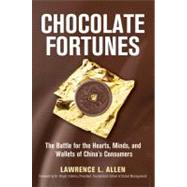
What is included with this book?
LAWRENCE L. ALLEN (Beijing, China) is a former senior executive for both Hershey and Nestlé in China. He has spent more than 20 years building consumer brands for multinational companies in China.
| Foreword | p. ix |
| Acknowledgments | p. xii |
| Introduction: One Country, Three Centuries | p. 1 |
| China and Chocolate: East Meets West | p. 9 |
| China's Road from Communism to Market Socialism | p. 12 |
| The Evolution of the Global Chocolate Industry | p. 20 |
| Chinese and Chocolate: A Foreign and Exotic Curiosity | p. 22 |
| The Size of China's Chocolate Prize | p. 28 |
| Selling Chocolate | p. 31 |
| Selling Chocolate in China | p. 33 |
| Ferrero Rocher: Accidental Hero | p. 40 |
| Ferrero's Journey Along the Modern-Day Silk Road to China | p. 44 |
| China's Emancipated Consumers | p. 46 |
| Establishing a Route-to-Market in China | p. 49 |
| Ferrero's Struggle with Local Copycats | p. 56 |
| Did Ferrero Succeed in China? | p. 62 |
| Cadbury: One Billion Consumers | p. 70 |
| A Brief History of Cadbury Chocolate | p. 71 |
| Cadbury China | p. 73 |
| Cadbury's China Morass | p. 76 |
| Attempting to Turn the Tide | p. 85 |
| The Battle for Chocolate Bars | p. 88 |
| The Final Blow: A Breakdown of Leadership | p. 91 |
| Hershey: Back to Basics | p. 95 |
| The Hershey Company | p. 96 |
| Hershey's International Business | p. 98 |
| Hershey China | p. 103 |
| The First Season: 1995-1996 | p. 113 |
| The Second Season: 1996-1997 | p. 120 |
| The Third, Fourth, and Fifth Seasons: 1997-2000 | p. 126 |
| The Sixth Season: 2000-2001 | p. 134 |
| Under New Management | p. 138 |
| Epitaph | p. 140 |
| Nestle: China's Chocolate War Sideshow | p. 141 |
| A Brief History of Nestle | p. 143 |
| Nestle's Arrival in China | p. 145 |
| The Birth of Nestle China | p. 151 |
| Sweating the Assets and Reducing KitKat's Cost | p. 156 |
| The Launch of Nestle Wafer | p. 159 |
| In the Shadow of Nestle Wafer | p. 165 |
| Nestle Could Have Been a Contender | p. 171 |
| The Last Word on Nestle, Chocolate, and China | p. 174 |
| Mars: A Well-Regulated Militia | p. 176 |
| A Brief History of the Mars Candy Company | p. 179 |
| Mars's International Expansion | p. 182 |
| Mars's China Market Entry | p. 183 |
| Mars Versus Its Big Five Chocolate Competitors | p. 190 |
| Mars's Commitment to Market Leadership | p. 193 |
| Going the Distance: China's 10K Chocolate Race | p. 201 |
| The State of the Chocolate Market: 2008 | p. 203 |
| The Threat from Local Competitors | p. 213 |
| Managing China's Multitier Market Going Forward | p. 220 |
| Notes | p. 225 |
| Index | p. 238 |
| Table of Contents provided by Ingram. All Rights Reserved. |
The New copy of this book will include any supplemental materials advertised. Please check the title of the book to determine if it should include any access cards, study guides, lab manuals, CDs, etc.
The Used, Rental and eBook copies of this book are not guaranteed to include any supplemental materials. Typically, only the book itself is included. This is true even if the title states it includes any access cards, study guides, lab manuals, CDs, etc.